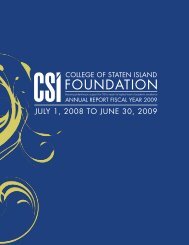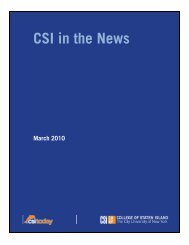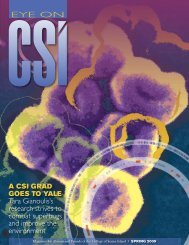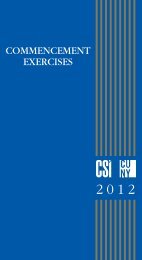csi undergraduate conference on research, scholarship ... - CSI Today
csi undergraduate conference on research, scholarship ... - CSI Today
csi undergraduate conference on research, scholarship ... - CSI Today
Create successful ePaper yourself
Turn your PDF publications into a flip-book with our unique Google optimized e-Paper software.
Research Poster Presentati<strong>on</strong>sP O S T E R 4 3Cl<strong>on</strong>ing of Critical Domain ofIno2p Resp<strong>on</strong>sible for RecruitingChromatin Remodeling ActivitiesEugene LempertFaculty Mentor: Dr. Chang-Hui ShenDepartment of BiologyThe INO1 gene codes for inositol-1-phosphatesynthase, which catalyzes the rate-limiting step inthe c<strong>on</strong>versi<strong>on</strong> of glucose-6-phosphate to inositol-3-phosphate. This intermediate is used in theproducti<strong>on</strong> of phophatidylinositol and otherimportant phospholipids and phosphoinositides.When inositol becomes limiting, INO1 activity isupregulated by the Ino2p-Ino4p dimer; in thepresence of inositol, Opi1p inactivates the Ino2p-Ino4p dimer, thus downregulating INO1transcripti<strong>on</strong>. According to our <strong>research</strong> and thework of others, the Ino2p-Ino4p dimer interactswith the UASino elements in the INO1 promoterand recruits chromatin-remodeling complexes,such as SWI/SNF and the Ino80p-associatedcomplex. The structure of the Ino2p subunitc<strong>on</strong>tains two transcripti<strong>on</strong>al activator domains, arepressor interacti<strong>on</strong> domain, and a basic helixloop-helixmotif that it shares with Ino4p. Todetermine the necessity of each domain, truncatedversi<strong>on</strong>s of the INO2 gene were produced usingpolymerase chain reacti<strong>on</strong> and ligated into aplasmid c<strong>on</strong>taining a TRP1ARS1CUP1 sequence.This sequence allows for selectivity of transformedino2 delta yeast cells and selective activati<strong>on</strong> of thetruncated INO2 variants. In order to determinewhich INO2 variants would save the cells frominositol auxotrophy, individual col<strong>on</strong>ies c<strong>on</strong>taining<strong>on</strong>e versi<strong>on</strong> of the INO2 sequence were grown inmedia lacking inositol. The optical density wasrecorded over a 24-hour period and growth curveswere produced. Our current results indicate thatinositol auxotrophy can be avoided in cells thatc<strong>on</strong>tain a plasmid with the sequence coding for thesec<strong>on</strong>d transcripti<strong>on</strong>al activator domain.P O S T E R 4 4Interference in C<strong>on</strong>solidati<strong>on</strong> ofEmoti<strong>on</strong>al Learning of Pige<strong>on</strong>sGary Mulligan, Samantha ScicchignoFaculty Mentor: Dr. Edward MeehanDepartment of PsychologyUsing a series of training and interference sessi<strong>on</strong>s,White Carneaux pige<strong>on</strong>s were tested with stimuliassociated with different reinforcement outcomes,e.g., A++, B+, C- and X. In order to assess theirsensitivity to emoti<strong>on</strong>al learning (through PavlovianC<strong>on</strong>diti<strong>on</strong>ing). The birds were exposed to multipleschedules during training and then given retroactiveinterference sessi<strong>on</strong>s that included presentati<strong>on</strong> ofthe relevant (A, B, & C) and irrelevant (X) stimuliwithout reinforcement (extincti<strong>on</strong>). The birds werethen tested to explore the effect of the retroactivetasks <strong>on</strong> c<strong>on</strong>solidati<strong>on</strong> of emoti<strong>on</strong>al learning. Resultsindicated that the birds were sensitive to differentialoutcome and were discussed in terms of theinteracti<strong>on</strong> between Instrumental and PavlovianC<strong>on</strong>diti<strong>on</strong>ing as well as the emoti<strong>on</strong>al sensitivity ofthe Avian nervous system.47
















